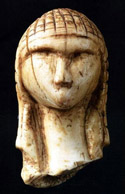Anthropology, Department of

Department of Anthropology: Faculty Publications
Document Type
Article
Date of this Version
5-8-2017
Citation
Arctic Science 3: 698–715 (2017) dx.doi.org/10.1139/as-2016-0057
Abstract
We estimated ages of rock cairns in alpine tundra in southeast Alaska by combining information from three general classes of methods, each of them imperfect, but considered together providing better estimates than any of the three alone. We used lichenometry, radiocarbon dating, and five successional metrics: score on a nonmetric multidimensional scaling axis of vegetation composition, cover-weighted average successional class of organisms, overgrowth of contact points between rocks, sum of species cover, and species richness. Lichenometry estimated absolute ages, but with considerable error because we violated key assumptions. Successional metrics provided relative ages, probably with more precision than lichenometry, but did not provide absolute ages. Although the relative age estimates from traditional lichenometry seemed least reliable, collectively they supported the hypothesis of prehistoric origins for the cairns with a range of possible absolute ages of 258–892 years. Similarly, radiocarbon dates for the cairns suggested cairn construction before European settlement, about 450–1500 years B.P. The five successional metrics were in general agreement with each other on relative ages. Combining all methods provided more information than any of the methods alone. We conclude that the cairns were built over a range of times, probably over centuries, most likely 500–1500 years B.P.


Comments
open access